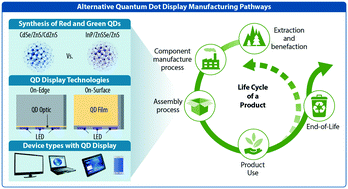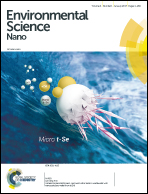Comparative cradle-to-gate energy assessment of indium phosphide and cadmium selenide quantum dot displays
Abstract
Quantum dots (QDs) are semiconductor nanocrystals (2–10 nm) with tunable band gaps and desirable luminescence properties. QDs have created great interest in consumer electronics, photovoltaics, and chemical and/or biological sensor applications. For example, QDs absorb short wavelength light and emit light with a desired wavelength, making them ideal for LCD displays. QDs are just beginning to be used in mass-produced displays, including products such as televisions, tablets, and smartphones. The most widely applied QD composition—a CdSe core metalloid complex (CdQD)—faces increasing environmental and regulatory scrutiny because cadmium and selenium nanomaterials pose uncertain human health and environmental risks. As a result, some manufacturers have introduced InP-based (InQD) displays, which have been shown to be less toxic than CdQDs. However, instead of basing environmental decisions on material hazard alone, it is important to take a more holistic approach to avoid unintended consequences. This paper presents a comparative cradle-to-gate life cycle environmental assessment of CdQD- and InQD-enabled displays. In this study, we compare the cumulative energy demand (CED), also referred to as the primary energy consumption, of colloidally synthesized CdSe and InP multishell QDs, and their subsequent incorporation in different display types. Additionally, we compare the CED for the two competing commercially available QD display technologies: on-surface and on-edge. Lastly, we estimate the energy repercussion of large-scale adoption of each of the production pathways for QD display manufacture. The results show that InP QD-enabled displays are far more energy intensive than the CdSe QD displays, and this difference becomes further amplified when large-scale adoption is considered. Our study highlights that life cycle thinking is essential for recognizing opportunities to advance QD production along environmentally sustainable pathways, which is critical information for researchers, QD display manufacturers, and regulatory agencies.



 Please wait while we load your content...
Please wait while we load your content...